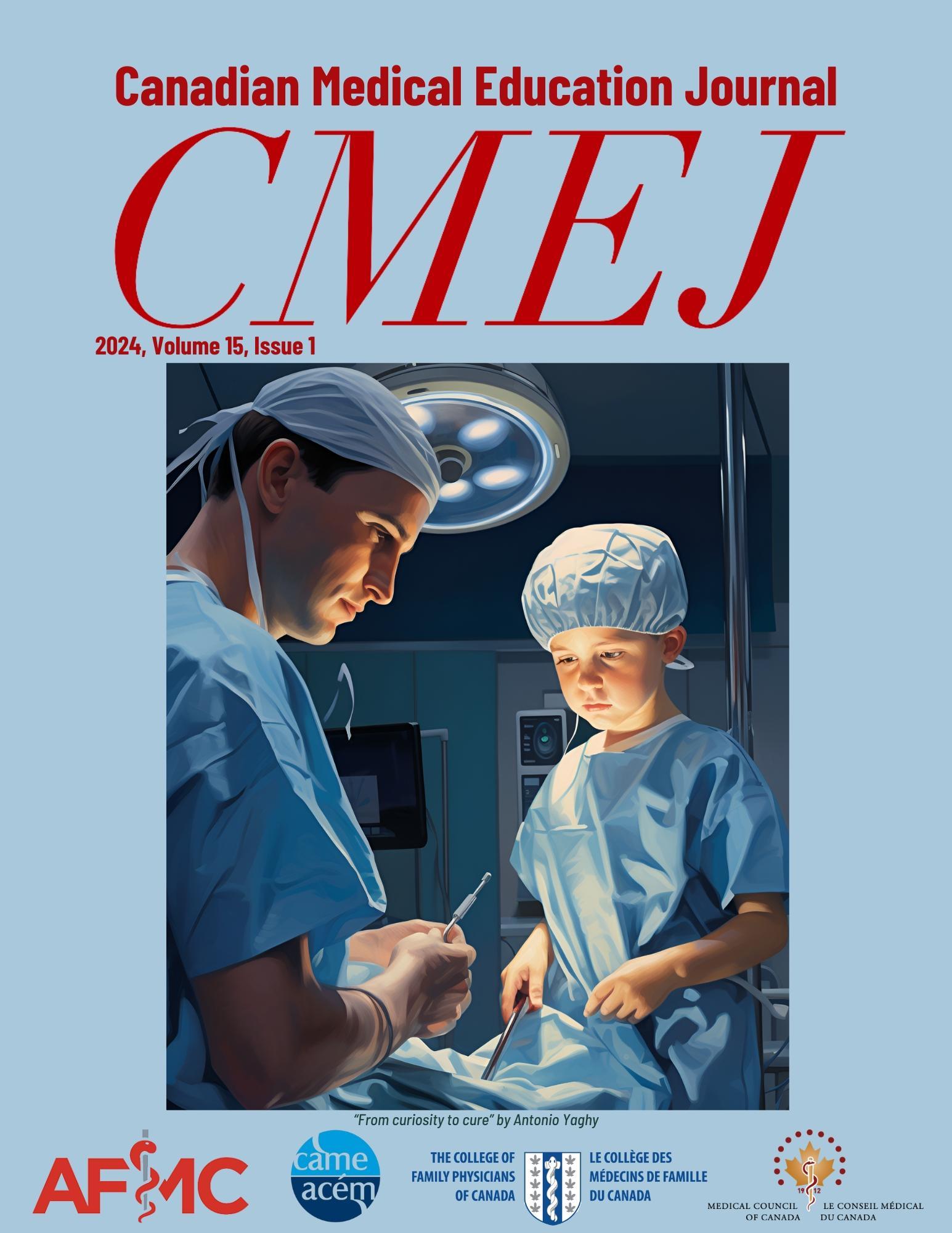Abstracts
Abstract
Background: Applicants to ophthalmology have high rates of going unmatched during the CaRMS process, but how this compares to other competitive or surgical specialties remains unclear. Our research aims to examine this phenomenon by identifying trends and comparing match data with other specialties, to identify disparities that may inform the need for future interventions to improve the match process for applicants.
Methods: We used a cross-sectional analysis of data provided by CaRMS on the residency match from 2013 to 2022.
Results: We obtained data from 608 ophthalmology, 5,153 surgery, and 3,092 top five (most competitive) specialty first choice applicants from 2013-2022. Ophthalmology applicants were more likely to go unmatched (18.9% [120/608]) than applicants to the top five (11.9% [371/3,092]) and surgical (13.5% [702/5,153]) specialties (p<0.001) and were twice as likely to rank no alternate disciplines (31.8%, p < 0.001) over the study period. In the first iteration, when alternate disciplines were ranked, the match rate to alternate disciplines was highest for ophthalmology applicants (0.41, p < 0.001). The majority (57.8%) of unmatched ophthalmology applicants do not participate in the second iteration.
Conclusion: Compared to other competitive specialties, first choice ophthalmology applicants were more likely to go unmatched, rank no alternate disciplines, and choose not to participate in the second iteration. Ophthalmology applicant behaviours should be further studied to help explain these study findings.
Résumé
Contexte : Les candidats à l'ophtalmologie ont un taux élevé de non-jumelage au cours du processus CaRMS, mais une comparaison avec d'autres spécialités compétitives ou chirurgicales reste à faire. Notre travail a pour but d’examiner ce phénomène en identifiant des tendances et en comparant les données de jumelage avec celles d'autres spécialités, à la recherche de disparités susceptibles d'éclairer le besoin d'interventions futures pour améliorer le processus de jumelage pour les candidats.
Méthodes : Nous avons procédé à une analyse transversale des données fournies par CaRMS sur le jumelage des résidents de 2013 à 2022.
Résultats : Nous avons obtenu des données sur 608 candidats en ophtalmologie, 5 153 en chirurgie et 3 092 candidats dont le premier choix était l’une des cinq spécialités les plus compétitives de 2013 à 2022. Les candidats en ophtalmologie étaient plus susceptibles de ne pas être jumelés (18,9 % [120/608]) que les candidats aux cinq spécialités les plus compétitives (11,9 % [371/3 092]) et aux spécialités chirurgicales (13,5 % [702/5 153]) (p<0,001), et étaient deux fois plus susceptibles de ne classer aucune autre discipline (31,8 %, p<0,001) au cours de la période d'étude. Lors du premier tour, lorsque des disciplines alternatives ont été classées, le taux de jumelage avec les disciplines alternatives était le plus élevé pour les candidats en ophtalmologie (0,41, p<0,001). La majorité (57,8 %) des candidats non jumelés en ophtalmologie ne participent pas au deuxième tour.
Conclusion : Comparativement à d'autres spécialités compétitives, les candidats dont le premier choix étaient l’ophtalmologie étaient plus susceptibles de ne pas être jumelés, de ne pas classer d'autres disciplines et de choisir de ne pas participer au deuxième tour. Les comportements des candidats en ophtalmologie devraient faire l'objet d'études plus approfondies afin d'expliquer nos résultats.
Download the article in PDF to read it.
Download
Appendices
Bibliography
- Ruth Wilson C, Bordman ZN. What to do about the Canadian Resident Matching Service. Can Med Assoc J. 2017 Nov 11;189(47):E1436–47. https://doi.org/10.1503/CMAJ.170791
- Ryan T. Addressing bias and lack of objectivity in the Canadian resident matching process. Can Med Assoc J. 2018 Oct 9;190(40):E1211–2. https://doi.org/10.1503/CMAJ.70008
- Krauss EM, Bezuhly M, Md W, Frcsc M, Williams JG. Selecting the best and brightest: a comparison of residency match processes in the United States and Canada. Plas Surg. 2015;23(4):225–30. https://doi.org/10.4172/PLASTIC-SURGERY.1000943
- Canadian Resident Matching Service (CaRMS). R-1 data and reports. Available from: https://www.carms.ca/data-reports/r1-data-reports/ [Accessed on Feb 25, 2023].
- Mah JM, Kherani IN, Hurley B. Trends in Canadian ophthalmology residency match outcomes. Can Med Educ J. 2020 Jun 4;11(3):e67–72. https://doi.org/10.36834/CMEJ.69809
- Baerlocher MO, Noble J. Does sex affect the success rate of Canadian ophthalmology residency applicants? Can J Ophthamol. 2006 Apr 1;41(2):163–8. https://doi.org/10.1139/I06-003
- Warsh F. Robert Chu’s suicide sends a message medicine cannot ignore. Toronto Star. 2017 Jun 20. Available from: https://www.thestar.com/opinion/commentary/2017/06/20/robert-chus-suicide-sends-a-message-medicine-cannot-ignore.html [Accessed on Feb 25, 2023].
- Bandiera G, Abrahams C, Ruetalo M, Hanson MD, Nickell L, Spadafora S. Identifying and promoting best practices in residency application and selection in a complex academic health network. Acad Med. 2015 Dec 1;90(12):1594–601. https://doi.org/10.1097/ACM.0000000000000954
- Canadian Federation of Medical Students. Details on CFMS supports for Match Day [Internet]. Available from: https://www.cfms.org/what-we-do/education/unmatched-support. [Accessed on Feb 25, 2023].
- Zafar A, Birak C. “You feel like your world is over”: problems and solutions for medical graduates without residencies. CBC News. 2018 Apr 11. Available from: https://www.cbc.ca/news/health/medical-residents-match-1.4614534. [Accessed on Feb 25, 2023].
- Dunkley J. CaRMS: the fortress between medical school and residency. 2018. Available from: https://cmajblogs.com/carms-the-fortress-between-medical-school-and-residency/. [Accessed on Feb 25, 2023].
- Okoniewska B, Ladha MA, Ma IWY. Journey of candidates who were unmatched in the Canadian Residency Matching Service (CaRMS): a phenomenological study. Can Med Educ J. 2020 Jun 5;11(3):e82–91. https://doi.org/10.36834/CMEJ.69318
- The Association of Faculties of Medicine of Canada (AFMC). Reducing the number of unmatched Canadian medical graduates. 2018. Available from: https://www.afmc.ca/wp-content/uploads/2022/10/AFMC_reportreducingunmatchedcdnmg_EN.pdf. [Accessed on Apr 6, 2023].
- Bumsted T, Schneider BN, Deiorio NM. Considerations for medical students and advisors after an unsuccessful match. Acad Med. 2017 Jul 1;92(7):918–22. https://doi.org/10.1097/ACM.0000000000001672
- The Association of Faculties of Medicine of Canada. Undergraduate students, electives, & MD graduates. Available from: https://www.afmc.ca/resources-data/education/undergraduate-students-electives-md-graduates/ [Accessed on Apr 7, 2023].
- Nguyen AXL, Bélair ML, Clark I, et al. The Association of Faculties of Medicine of Canada Student Elective Diversification Policy: perspectives in ophthalmology. Can Med Educ J. 2022 Jan 7;13(2):101–2. https://doi.org/10.36834/CMEJ.74051
- Courneya CA, Cheung W, McMillan MJ. High dives and parallel plans: relationships between medical student elective strategies and residency match outcomes. Can Med Educ J. 2020 Aug 4;11(3):e4. https://doi.org/10.36834/cmej.53018

